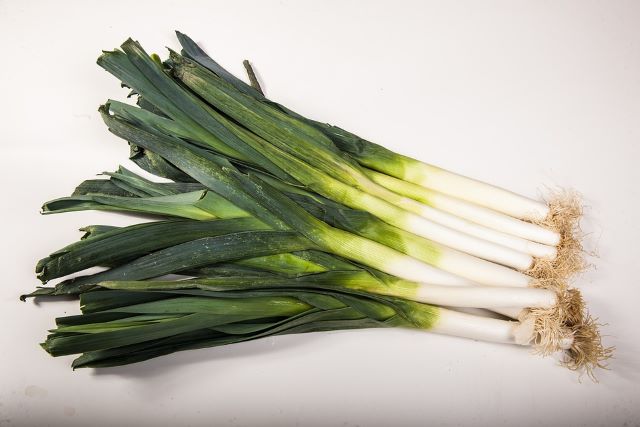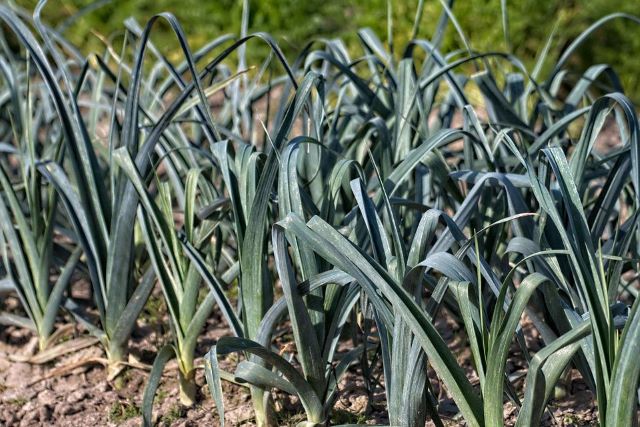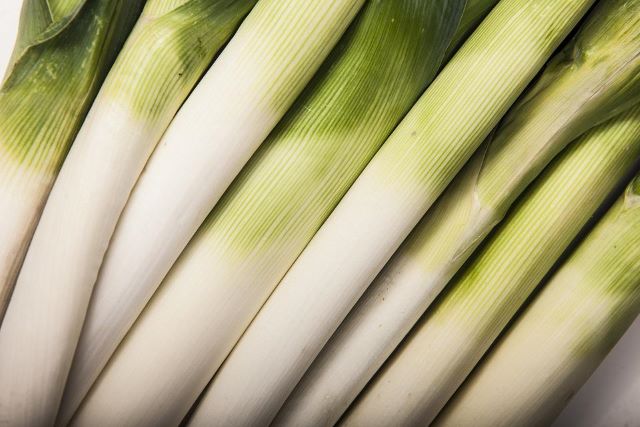Leeks are a popular vegetable many gardeners love to add to their veggie patch. Leek plants grow long, green, and narrow as they mature. And as leeks grow closer to being ready to harvest, their leaves will grow thicker, and their texture becomes less tender. But when leeks are thin they can be underwhelming and disappointing. So in this article, we’ll look at why leeks are so thin and how to fix them.

When leeks are thin the most common causes are overcrowded leek plants, watering problems, poor soil conditions, disease and pests, and the wrong companion plants.
Let’s take a look at each cause of thin leeks and solutions to grow a thriving harvest of leeks.
Table of Contents
Leek Plants are Crowded Causing Thin Leeks
One of the most prominent reasons for thin leeks is overcrowding in your garden beds. As a rule of thumb, leek plants should have at least 6 inches (15 cm) between them or other vegetables. Leek plants also need space underground for their shallots to grow and thrive.
To prevent overcrowding your leeks, do not broadcast seeds. Broadcasting is the process of hand throwing the seed over the soil (and can also be done by machine in farming). This may cause the leek plants to grow too close together, which can then cause issues with disease and other poor growing conditions.
However, if you do choose this method of planting your leek seeds, you can still thin out the seedlings once they have sprouted to allow them more garden space. Aim to thin leek seedlings at around 4 weeks.
You don’t have to discard them, instead, gently remove the baby leeks from the soil and add them to your next meal. Or, you replant the leek seedlings in another section of your garden.
Watering Problems Cause Thin Leeks

Leek plants require adequate watering on a daily basis. When under-watered, you will notice wilted or thin leek leaves and stems.
To ensure proper watering of your leek plants, you should stick to a watering schedule. During dry periods be sure to provide leeks with additional water to prevent them from drying out.
Mulching around the leek plants will also help ensure the soil doesn’t dry out. Mulch protects the soil as well as the leek plant roots and keeps weeds at bay.
Overwatering can also be the cause of discolored or thin leeks.
Check the soil around the leek plant base to detect moisture. You can check the soil by gently scratching the surface of the soil. If the soil is still moist an inch below the surface, hold off watering until the soil dries out a little.
Check the drainage of your soil. Leeks prefer free-draining soil and won’t grow as well in waterlogged or boggy soil.
If you’re growing leeks in pots, consider drilling additional holes into them if needed. This will prevent water pooling and allow an adequate amount of water to get absorbed into the roots of your leek plant.
Poor Soil Conditions Cause Thin Leeks
Leek plants are heavy feeders, and their soil needs to be balanced with nitrogen-rich fertilizer to ensure proper growth and bountiful harvest.
Fertile soil will encourage leek plants to thrive. So when planting your leeks, you should add compost and aged manure to the garden soil to provide it with the best nutrients from the start.
Compost is rich in organic matter, which allows the soil to retain air, water, and nutrients throughout the growing season.
Then use a nutrient-rich, organic fertilizer throughout the growing season. This organic fertilizer will keep your plants supplied with the proper vitamins and minerals needed for optimal harvest and delicious-tasting leeks.
Leek Plant Diseases Cause Thin Leeks
Disease can destroy entire crops of leek plants within one growing season. It’s important to quickly notice any disease so that it can be properly treated and eradicated. There are a few common diseases that can affect the leek plant family.
Rust
Rust is a common fungal disease that can cause small brown, raised spots to develop on the leaves of your leeks. This disease may even cause leaves to fall off the plant if it is undiagnosed and untreated.
To treat rust, you should avoid planting your leeks too close together. Rust thrives in humid conditions, so proper airflow is necessary.
Downy Mildew
Another fungal infection that can cause harm to the leek plants is downy mildew.
This infection will leave a milky residue on the leek leaves, which can eventually lead to gray mold. Mildew can spread through the wind and rainfall, making it difficult to prevent.
To treat this issue, use organic copper fungicide and keep the plant leaves dry.
White Rot
White rot can be a devastating disease that can quickly cause plant decay and even death in your leeks.
Symptoms of white rot include yellowing and thinning of leaves. Eventually, these leaves will wilt and fall off entirely.
Once white rot affects your plants, there is no way to treat or remove it. To prevent white rot, it is recommended to rotate crops and use new, clean soil each year.
Botrytis Leaf Blight
If you notice long, white spots on the leaves of your leeks, you may be suffering from Botrytis leaf blight. This disease will kill the entire plant, leaving the leek stalk inedible and leaves to die.
To prevent this leaf blight, you need to provide your leek plants with plenty of space for proper airflow and allow adequate water drainage.
Pest Attack Causes Thin Leeks
Like many other plants and garden vegetables, leeks are prone to pests and insects. When these insects feed on the leaves or stalks of your leek plants, they can become thin, withered, brown in color, or many other issues. There are a few insects that may target your leek plants.
Leek Moths
As its name suggests, leek moths will specifically target the leaf plant.
The moth will feed on the delicious leaves of the leek plants, causing stunted growth and early decay of the plant. These moths are easy to spot and treat.
One of the best methods to prevent leek moths from destroying your crops is to use row covers. These row covers will keep your plants safe from any moths during the nighttime, and they can be easily removed for water and sunlight during the day.
Onion Thrips
These small insects will feed on the newly growing leaves of your leek plants. They are predominantly found on onion-family plants, and they can destroy the entire crop if they are not prevented quickly.
To detect for onion thrips, look for leaf curling, silver or white streaks on the leaves, and overall injury or decay on the plant.
Using horticultural neem oil is a safe and effective method of getting rid of them.
Leaf Miners
These small insects love to feed on any leaves produced by plants in the onion family, making leeks a perfect target.
They can cause the leaves to grow thin, discolored lines on your leek leaves. These are known as stipplings.
When you notice these discolorations, you need to treat the leek plant immediately with insecticide. As with onion thrips, neem oil is a safe and effective treatment to get rid of leaf miners.
To prevent leaf miners, you can use nets over your leek plants during their egg-laying season, which is typically late March through early May.
Onion Root Maggot
This insect will target the base of your leek plants, feeding on this portion until it becomes inedible. These small flies will leave their larvae on the stem of the plant, leaving them to feed on the roots and base of your plants.
To identify an onion root maggot infestation, you will need to notice stunted growth on younger plants. Older plants will become yellow in color until they decay.
Sticky Traps can catch the adults (who resemble flies) while Diatomaceous Earth around the leek plants can help control and eliminate the root maggots.
How to Safely Prevent and Treat Insect Issues on Leek Plants
Once you notice the presence of insects or other pests, you need to treat the plants to prevent further decay or even death. Luckily, these issues can be quickly spotted and treated to remove the pests and allow the plants to thrive.
There are a few ways that you can prevent or treat insect damage on your leek plants, such as:
- Use a safe insecticide like neem oil
- Keep the area around the plant clean by frequently weeding and removing decayed debris
- Prevent overwatering and moist conditions
- Rotate crops each growing season
- Use row covers at night
The Wrong Companion Plants For Leeks
There are a few plants that will sap nutrients from the soil, causing them to be poor companions for your leeks. Avoid planting any beans or peas in the same garden beds as your leek plants. Beans and peas will overpower the leeks by removing all the nutrients from the soil, leaving your leek plants struggling to thrive.
Instead, you should choose the right companions for your leek plant garden beds. Carrots, onions, celery, and beets are just a few of the plants that can encourage your leeks to prosper.
Leek Growing Tips
- Leeks are a cool-season vegetable and prefer to grow in temperatures below 75 °F (24 °C). They germinate best when temperatures are between 55-75 °F (13-24 °C).
- Plant leeks into a sunny location with at least 6-8 hours of sun a day.
- Grow leeks in fertile, free-draining soil. Amend soil with homemade compost and aged manure prior to planting to give leeks the best growing conditions.
- Keep the soil moist with a regular watering routine.
- Allow around 120-140 days of growing time for leeks, at which time a good size to harvest them is when their stalks are 1 inch (2.5cm) in diameter.
To Blanch Or Not To Blanch Your Leeks

Essentially, blanching is the process of blocking sunlight from reaching the leek stalk.
Blanching creates white and tender leeks stalks and is what we most often see sold in grocery stores. However, blanching doesn’t change the taste or texture substantially and may not be worth doing for merely an aesthetic quality to your vegetable.
These days you can also select leek seed varieties that are self-blanching, meaning they will grow a white stalk naturally. So you can achieve the desired ‘look’ without actually blanching them.
But if you are interested in blanching your leeks, it is usually done by one of two methods:
Hilling Leeks
Using this method, leeks are planted at normal ground level. Then hilling, or the building up of soil around the base of the leek plant, is done every few weeks during the growing season.
Simply add an inch or two of soil to the base of the leek plant, which will start to cover the stalk.
Aim to hill leeks up to 4-6 inches (10-15cm) during the growing season for lovely white blanched leeks.
Trenching Leeks
By planting your leeks in trenches of around 6 inches (15 cm) deep, you will have room to backfill them with soil as they grow.
By the end of the growing period, the trenches should be filled to ground level which will be around the 6-inch (15cm) mark.
Further reading:
- How to Grow Chives in Your Herb Garden
- Dying Chives? 6 Common Causes with Solutions
- Growing Bulb Onions: 20 Things You Should Know
- Why is Celery Bitter (And How to Fix It)
- How To Grow Celery For Juicing
- Why Is My Broccoli Turning Yellow? (And how to fix it)
- Why Is My Rhubarb Thin? (And How To Fix It)
- Parsley Dying? 6 Common Causes and Solutions
